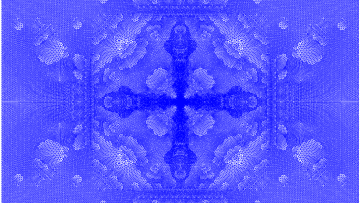14:00
RG Flows and Bounds from Chaos
Abstract
I will discuss a precise connection between renormalization group (RG) and quantum chaos. Every RG flow between two conformal fixed points can be described in terms of the dynamics of Nambu-Goldstone bosons of broken symmetries. The theory of Nambu-Goldstone bosons can be viewed as a theory in anti-de Sitter space with the flat space limit. This enables an equivalent formulation of these 4d RG flows in terms of spectral deformations of a generalized free CFT in 3d. This approach provides a precise relation between C-functions associated with 4d RG flows and certain out-of-time-order correlators that diagnose chaos in 3d. As an application, I will show that the 3d chaos bound imposes constraints on the low energy effective action associated with unitary RG flows in 4d with a broken continuous global symmetry in the UV. These bounds, among other things, imply that the proof of the 4d a-theorem remains valid even when additional global symmetries are broken.
Born out of lockdown in 2020, the Oxford Mathematics Online Exhibition might just have become a permanent fixture in our mathematical lives.
We ask all our Oxford Mathematicians, young and less young, to come up with art that expresses a mathematical idea in the form of their choice.
Image to the right: Joel Madly - Triangular mesh with fractal behaviour (click to see full detail)
Image below: Andrew Krause - Turing Pattern Faces (click to see full detail)
FFTA: Flow stability for dynamic community detection
Abstract
Many systems exhibit complex temporal dynamics due to the presence of different processes taking place simultaneously. Temporal networks provide a framework to describe the time-resolve interactions between components of a system. An important task when investigating such systems is to extract a simplified view of the temporal network, which can be done via dynamic community detection or clustering. Several works have generalized existing community detection methods for static networks to temporal networks, but they usually rely on temporal aggregation over time windows, the assumption of an underlying stationary process, or sequences of different stationary epochs. Here, we derive a method based on a dynamical process evolving on the temporal network and restricted by its activation pattern that allows to consider the full temporal information of the system. Our method allows dynamics that do not necessarily reach a steady state, or follow a sequence of stationary states. Our framework encompasses several well-known heuristics as special cases. We show that our method provides a natural way to disentangle the different natural dynamical scales present in a system. We demonstrate our method abilities on synthetic and real-world examples.
arXiv link: https://arxiv.org/abs/2101.06131
A Multi-Type Branching Process Method for Modelling Complex Contagion on Clustered Networks
Abstract
Online social networks such asTwitter, Facebook, Instagram and TikTokserve as mediafor the spread of information between their users.We areinterested in developing models forthis information diffusion to gain a greater understanding of its drivers. Some models forthe spread ofonlinebehaviour and informationassume that the information behaves similarly to a virus, where infection is equally likely after each exposure, these dynamics are known as a simple contagion. In a simple contagion, the exposures are independent of each other.However,online adoption of some behaviour and content has been empirically observed to be more likely after multiple exposures from their network neighbours, the exposures are not independent of each other, we refer to this as a complex contagion.Analytically tractable descriptions of complex contagions havebeendeveloped for continuous-time dynamics. These extend mean-field and pair approximation methods to account for clustering in the network topologies; however, no such analogous treatments for discrete-time cascade processes exist using branching processes. We describe a novel definition of complex contagion adoption dynamics and show how to construct multi-type branching processeswhichaccount for clustering on networks. We achieve this by tracking the evolution of a cascade via different classes of clique motifs whichaccount for the different numbers of active, inactive and removed nodes. This description allows for extensive MonteCarlo simulations (which are faster than network-based simulations), accurate analytical calculation of cascade sizes, determination of critical behaviour and other quantities of interest
13:00
Calabi-Yau Metrics from Machine Learning
Please note that the time of this meeting has been changed to 13:00.
Abstract
We use machine learning to approximate Calabi-Yau and SU(3)-structure metrics, including for the first time complex structure moduli dependence. Our new methods furthermore improve existing numerical approximations in terms of accuracy and speed. Knowing these metrics has numerous applications, ranging from computations of crucial aspects of the effective field theory of string compactifications such as the canonical normalizations for Yukawa couplings, and the massive string spectrum. In the case of SU(3) structure, our machine learning approach allows us to engineer metrics with certain torsion properties. Our methods are demonstrated for Calabi-Yau and SU(3)-structure manifolds based on a one-parameter family of quintic hypersurfaces in ℙ4.
I briefly give an overview on the key ML frameworks involved in this analysis (neural networks, auto-differentiation). This talk is mainly based on 2012.04656.
The continuous gradability of the cut-point orders of R-trees
Abstract
An $\mathbb R$-tree is a metric space tree in which every point can be branching. Favre and Jonsson posed the following problem in 2004: can the class of orders underlying $\mathbb R$-trees be characterised by the fact that every branch is order-isomorphic to a real interval? In the first part of the talk, I answer this question in the negative: there is a branchwise-real tree order which is not continuously gradable. In the second part, I show that a branchwise-real tree order is continuously gradable if and only if every embedded well-stratified (i.e. set-theoretic) tree is $\mathbb R$-gradable. This tighter link with set theory is put to work in the third part answering a number of refinements of the main question, yielding several independence results.


